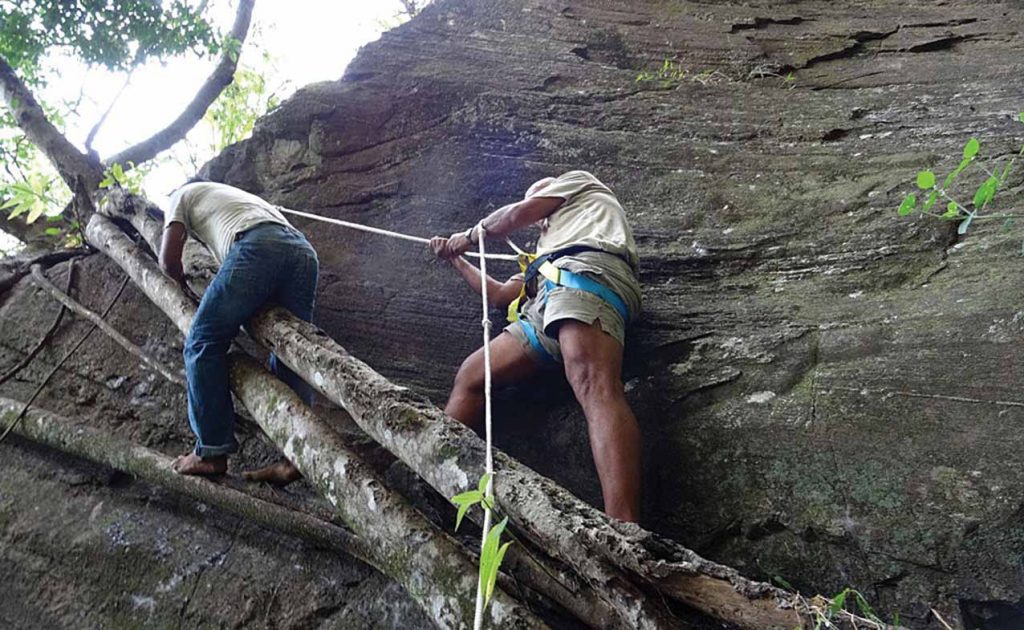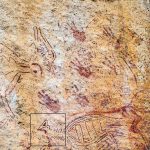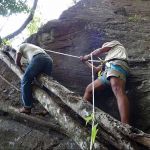THE MYSTERIOUS ROCK ART OF KURULLANGALA
Posted on April 4th, 2017
BY STEFAN D’SILVA Courtesy Asian Art
The artwork was discovered by a few local lads in the late 1980s (according to one of them) and a few years later the discovery was released to a local school newspaper called Lalitha (2002, article by Asoka Somaratne). Eleven years later, in 2013, the TV station, Derana, made a short story on the site, but did not disclose the actual location. Eventually, a few intrepid and enthusiastic people researched the available information and visited the site. It is plausible that other villagers in the area may have also known of this art work, but did not see a need to mention it as an important cultural discovery. It is also plausible that the lads’ parents may have known of the art work but did not attach any importance to it either.
It is currently claimed to be the largest collection of rock art found in Sri Lanka to date, covering a surface area of about 1.3 metres by 0.48 metres. One of the outstanding features of the art is that it is on a ‘rock wall’ open to the elements, at all times of the year, with no natural shelter of any sort. However, one cannot completely rule out that this art in earlier times may have been in a cave or a shelter spot and, over time, there may have been some seismic activity or landslides that altered the original site to what it is today.
The paintings face east with the first rays of the rising sun illuminating the rock surface. Some of the art is quite high, about 5 to 7 metres. There is no explanation, or theory, to date as to how the artists got so high on the rock surface and how a ‘steady hand’ could have been maintained to draw the art at such a height. A recent examination and thesis by an art and sculptor university graduate from the University of Visual and Performing Art in Colombo, Ruwan believes after examination that the art work is brush stroke and not the finger-painted work of Veddahs (the indigenous people of Sri Lanka). One may also draw the difference in comparison to other well-known rock/cave/temple art work in Sri Lanka. Kurullangala stands unique and mysterious as an art work in itself in Sri Lanka.

Unlike many of the historic cave art sites in Sri Lanka there is no visible drip ledge overhang, nor are there any rock inscriptions of ancient language or script to be seen. Familiar Sri Lankan animals are not seen in this art work such as elephant, the cobra hood, buffalo, monkey, Sambhur/deer, bear and leopard. Birds dominate the drawings, with some of the larger depictions about 42 cm high. The art is overlapping with some images drawn on top of others. More than one type of bird is depicted with at least one image seeming to be a small bird in flight. There are also four visible human-like images with what appears to be some type of reptile, or mammal, and a number of left-hand palm prints. Also including in the drawings are lines, dots and a small ‘lattice’ drawing. Some of the bird drawings are perpendicular, some at angles and some horizontal.
According to a recent, preliminary 2016 Post Graduate Institute of Archaeology (PGIAR) report analysis states that red and yellow pigments were used in the making of the images. The red pigment is claimed to be iron oxide. However, due to the pigments being inorganic, carbon dating is not possible. The PGIAR’s report also states that the yellow pigment used is unique to rock art in Sri Lanka. Yellow has been used as a background for the red pigment drawings and there are obvious traces of white paint. The art seems to be directly painted on the rock face- unlike the frescoes from the Anuradhapura period (377 BC to AD 1017) found at Sigiriya, the ancient rock fortress in Central Province, for example, that has a prepared plaster wall for a ‘canvas’. There are some cave art palm prints at Mangulmaha Vihara in Yala National Park in the south, however, they are of both left and right hand palm prints, of two colours, and the art is in a sheltered cave. (It is possible that there is a mistake in the spelling of Mangulmaha Vihara and that the cave is within the monastic grounds of Magulmaha Vihara.)
The similarity to the Aboriginal rock art in Australia is striking, as some of that art is in ‘open’ rock shelters. However, the Aboriginal palm prints are ‘stencilled’ hand prints. To the lay person, the temptation to draw similarities of some of the bird art to an emu and cassowary is strong. Whilst that is pure speculation, it certainly does not diminish the intrigue.
The peacock has mythical and sacred connotations especially in the Uva region (as it related to the Ravana Legend and the Ramayana). Our local guide, a ‘Ravana believer’, believes the bird artwork is of peacocks and is associated with the Ravana Legend. Ultimately, the consensus of academic opinion of what these birds are likely to be will emerge in the course of time.
Further speculation suggests the site may have been a sacred place or a place of worship (bird worship?). The lack of any evidence, to date, of an overhang, or cave, indicates it was probably not a site that people might have inhabited. According to a recent preliminary exploration report from the Uva Regional Office, the closest known pre-historic sites are at Randeniya – Keeriyagolle Kiridi Oya Basin in the southern dry zone. It is possible that the artists picked an imposing site for a sacred space looking down upon local habitation.
The human like figures seem to be unlike other human figures in other cave art in Sri Lanka. The Uva report suggests the figures are ‘looking’ to the north. The report also suggests the human like figures may be holding feathers. It certainly seems to be the case that there may have been two (or more) styles of art in Sri Lanka being practised simultaneously at a given time in history, for example the Veddah ‘finger’ art, other styles of cave art, and the Kurullangala style of art.
It calls for a multidisciplinary team of academics to examine and study the site, the surrounding area and the boulders below the cliff face. It is also difficult to accept that the artists only chose one corner to work on when a huge rock ‘canvas’ was available (perhaps another indication that many years ago there may have been a cave/shelter at the art site).
The discovery is exciting and certainly stands to alter and add to the ancient history of Sri Lanka. It certainly one of the most important recent discoveries in Sri Lanka and needs help in being protected.
BY STEFAN D’SILVA
References and Acknowledgements
An Account of the Recently Discovered Rock Art site at Kurullangala, Ella Sri Lanka; Laboratory of Cultural Material Analysis Publication – series 4.
PGIAR Publication by Arjuna Thanthilage, Ranjith Bandara Disanayake, Chanidima Bogahawatta, Indika Vithanage, Jampath Senanayake, TK Wijesinghe and ELMSS Ekanayake.
Exploration report of art found on the rock face of Karadagolla – Kurullangala-2013. 09.03-Exportation Unit-Uva Provincial Archaeology Office
Rock Painting and Engraving Sites in Sri Lanka – Raj Somadeva- PGIAR publication
An Initial Study of Kurullangala Primary Drawings Archaeological Dept of Peradeniya University -by Gampola Vijitha Thero and RDA Shantha
Acknowledgement is also made to Ms Neranjana Gunatilleke and Ruwan for their assistance, discussion, suggestions, hard work and contributions in examining the paintings and pointing out certain issues






April 5th, 2017 at 3:20 am
I see a money making opportunity here for the country.GOSL must not make it into another absurd sacred area. Keep religion out f it.Make all the facilities in line with the modern world where toilets are properly maintained.
Give the maintenance contract to a well known private company as our state paid employee are utterly hopeless and not up to it.
Keep touts and perverts out of the area.Sigirya is full of them.
Advertise this site in the web using the best people to submit the site to many search engines using the right key words.
Politicians and priests should never be allowed in this venture that should benefit everyone in the country. They seem to have a unfair cruel monopoly of every thing in our country’s economy supporting ventures.
This is good news for our island.
Private established company will do every thing necessary to promote and maintain this.